

Je m'appelle James Baldwin (1/3) : James Baldwin : "Quand les choses vont mal dans mon pays, cela va encore plus mal pour les Noirs" James Baldwin (1/4) : Sexe et race. Pour évoquer la vie de cet écrivain américain, qui résida en France durant l’essentiel de sa vie, nous recevons Virginie Depardieu, professeure de littérature à l’Université du Havre.
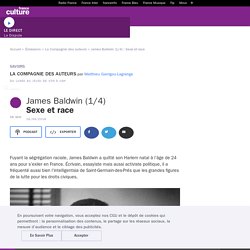
Spécialiste de littérature africaine-américaine, elle a consacrée sa thèse à James Baldwin, qu’elle a fait paraître en 2006 aux éditions l’Harmattan sous le titre Et hélas ! Baldwin, le Noir et la Palestine. Texte inédit pour le site de Ballast.
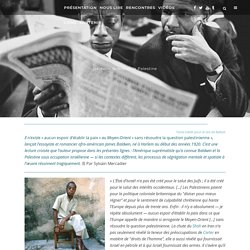
The Glow From ‘The Fire Next Time’ Fifty-five years ago last month, The New Yorker published Baldwin’s astonishing essay about the United States teetering on a precipice.
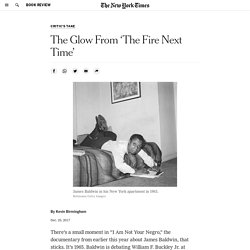
“Privately,” Baldwin wrote, “we cannot stand our lives and dare not examine them; domestically, we take no responsibility for (and no pride in) what goes on in our country; and, internationally, for many millions of people, we are an unmitigated disaster.” The national reckoning that we now know as “The Fire Next Time” begins with Baldwin’s salvation. At 14, he found himself writhing on his church’s floor, experiencing a pain “like one of those floods that devastate counties, tearing everything down.” He became a child preacher reveling in his congregation’s exclamatory community (“Amen!” “Yes, Lord!”) The resemblance leads to Baldwin’s insight that churches, nations and races are fantasies intended to evade death, whereas we should confront “with passion the conundrum of life.” This was the message that brought the Cambridge students to their feet.
Témoin Baldwin: Les Algériens à Paris dans les années 50 - Part 1 (10 mn) by Collectif James Baldwin. Why James Baldwin's 'A Talk To Teachers' Remains Relevant 54 Years Later. Fifty-four years ago, American writer and social critic James Baldwin delivered a speech to educators about how to speak with their students during difficult times.

Many of the issues from that speech are still relevant today. Les chemins de la connaissance - Je m'appelle James Baldwin 3/3 : Parties 4 et 5 (1ère diffusion : 23 et 24/04/1987) ET MON CACHOT TREMBLA - Lettre à mon neveu à l'occasion du centenaire de l'émancipation. 7 Minutes de réflexion // GET OUT. Sonny's Blues. "Sonny’s Blues" (1957)[1] is a short story by James Baldwin.
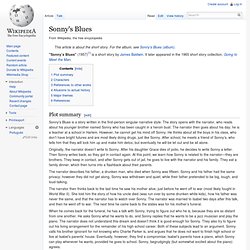
It later appeared in the 1965 short story collection, Going to Meet the Man. Plot summary[edit] Sonny's Blues is a story written in the first-person singular narrative style. The story opens with the narrator, who reads about his younger brother named Sonny who has been caught in a heroin bust. The narrator then goes about his day; he is a teacher at a school in Harlem.
Originally, the narrator doesn’t write to Sonny. The narrator describes his father, a drunken man, who died when Sonny was fifteen. The narrator then thinks back to the last time he saw his mother alive, just before he went off to war (most likely fought in World War II). When he comes back for the funeral, he has a talk with Sonny, trying to figure out who he is, because they are so distant from one another. "Sonny's Blues" Lecture. Analysis of 'Sonny's Blues' by James Baldwin. "Sonny's Blues" by James Baldwin was first published in 1957, which places it at the heart of the civil rights movement in the United States.

For those of you who need to be reminded of the timeline, that's three years after Brown v. Board of Education (1954), two years after Rosa Parks refused to sit at the back of the bus (1955), six years before Martin Luther King, Jr., delivered his "I Have a Dream" speech (1963), and seven years before President Johnson signed the Civil Rights Act of 1964. Plot The story opens with the first-person narrator reading in the newspaper that his younger brother -- from whom he is estranged -- has been arrested for selling and using heroin.
The brothers grew up in Harlem, where the narrator still lives. For several months after the arrest, the narrator does not contact Sonny. Sonny’s Blues. "Sonny's Blues" by James Baldwin. The most famous jazz short story. Starring Saul Williams and Charles Parnell video on Cinely. The Importance of Blues Music in James Baldwin's "Sonny's Blues" par Madison Natt sur Prezi. SONNY'S BLUES BY: JAMES BALDWIN (Monologue) James Baldwin’s “Sonny’s Blues” — World Literature. The narrator of James Baldwin’s “Sonny’s Blues,” like many of us, needs to learn how to listen.
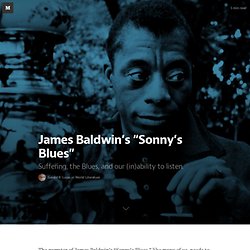
How many of us truly listen? Or do we just wait for someone we might be talking to to shut the hell up so we can continue our verbal assault without the slightest consideration as to what she might have to say? How often do we find ourselves thinking about what we’re going to next pull out of our word hoards rather than attempting to hear what someone else might have to say? Perhaps others are just as guilty. Maybe they need to listen to what I have to say. Indeed, much of what we’re taught probably reflects the music we find most pleasing.
The narrator of “Sonny’s Blues” is the same way. These boys, now, were living as we’d been living then, they were growing up with a rush and their heads bumped abruptly against the low ceiling of their actual possibilities. The narrator had escaped and made something of himself, and he desperately wanted his brother to do the same. Sonny's Blues - Inspired by James Baldwin's Short Story - Starring Saul Williams and Charles Parnell. Sonnysblues.pdf. Short Story Review — Sonny’s Blues by James Baldwin. Short Story Review — Sonny’s Blues by James Baldwin Posted by zimmermanbri on September 22, 2011 · Leave a Comment James Baldwin was one of the most brilliant and influential writers of the mid 20th century.
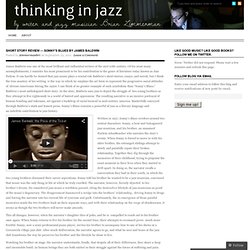
Of his most many accomplishments, I consider his most prominent to be his contribution to the genre of literature today known as Jazz Fiction. It can hardly be denied that jazz music plays a crucial role Baldwin’s short-stories, essays, and novels, but I think the true mastery of his writing is the way in which he employs the art form to represent the progressive social attitudes of African-Americans during the 1950s. Black Culture Book Club: Sonny’s Blues by James Baldwin. It was Mary McLeod Bethune who said, “The whole world opened to me when I learned to read”.
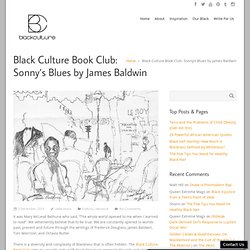
We vehemently believe that to be true. We are constantly opened to worlds past, present and future through the writings of Frederick Douglass, James Baldwin, Toni Morrison, and Octavia Butler. There is a diversity and complexity of Blackness that is often hidden. The Black Culture Book Club aims to unearth and uplift black literature, exposing the rich and strong history of black folk, as well as the beauty and vibrancy of our culture. Every month we’ll read a new book. How the Book Club Will Work We will be making monthly announcements about the Book Club here on the main site, while encouraging discussion on the public Good Reads Group called the “Black Culture Book Club“. Book Discussions will be broken down by grouped chapters allowing readers to participate in according to what they have read. Read Alongs are discussions of monthly posted short stories. Schedule.